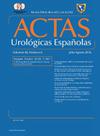Comparación del P-score de Prostatype® y los modelos de riesgo tradicionales para predecir los resultados del cáncer de próstata en España
IF 1.2
4区 医学
Q3 UROLOGY & NEPHROLOGY
引用次数: 0
Abstract
Introduction
Prostate cancer (PCa) shows varied aggressiveness, complicating personalised treatment decisions. Traditional risk stratification systems rely on clinical parameters but may miss crucial genetic insights. The Prostatype® score (P-score) integrates gene expression with clinical data to improve PCa risk assessment precision.
Objectives
To validate the P-score's predictive performance for prostate cancer-specific mortality (PCSM) and metastasis in a Spanish cohort, comparing it with NCCN, D’Amico, and EAU systems.
Materials and Methods
This study was multicentre, retrospective and included seven Spanish hospitals. Of 154 core needle biopsies, 93 met RNA criteria, and for those, P-score was calculated based on IGFBP3, VGLL3, and F3 genes expression and clinical data.
The primary endpoint was PCa-specific mortality (PCSM), with secondary endpoints being development of metastasis, adverse pathology (AP), and International Society of Urological Pathology (ISUP) grading.
Results
The P-score demonstrated superior accuracy in predicting 10-year PCSM, with an AUC of 0.81 and a C-index of 0.75, outperforming NCCN (AUC 0.77, C-index 0.69) and D’Amico/EAU (AUC 0.70, C-index 0.62). For metastasis prediction, the P-score achieved a C-index of 0.77, significantly higher than NCCN, D’Amico, and EAU (0.58). Kaplan-Meier analysis underscored the P-score's ability to better stratify patients by risk, especially high-risk groups. Additionally, the P-score correlated with tumour burden, showing significant associations with positive biopsy cores (p = 0.017) and ISUP grade at radical prostatectomy (p = 0.0028).
Conclusions
In this Spanish cohort, the P-score outperformed traditional clinicopathological systems in predicting PCSM, development of metastasis, and pathological markers, supporting its clinical utility for more personalised PCa management.
在西班牙,Prostatype®的p分数与传统风险模型预测前列腺癌结果的比较
前列腺癌(PCa)表现出多种侵袭性,使个性化治疗决策复杂化。传统的风险分层系统依赖于临床参数,但可能错过关键的遗传见解。前列腺类型评分(P-score)将基因表达与临床数据相结合,以提高前列腺癌风险评估的准确性。目的在西班牙队列中验证p评分对前列腺癌特异性死亡率(PCSM)和转移的预测性能,并将其与NCCN、D 'Amico和EAU系统进行比较。材料与方法本研究为多中心、回顾性研究,纳入7家西班牙医院。154例核心穿刺活检中,93例符合RNA标准,根据IGFBP3、VGLL3和F3基因表达及临床数据计算p评分。主要终点是前列腺癌特异性死亡率(PCSM),次要终点是转移的发生、不良病理(AP)和国际泌尿病理学会(ISUP)分级。结果p -评分预测10年PCSM的准确率较高,AUC为0.81,c -指数为0.75,优于NCCN (AUC 0.77, c -指数0.69)和D 'Amico /EAU (AUC 0.70, c -指数0.62)。对于转移预测,p -评分的c指数为0.77,显著高于NCCN、D 'Amico和EAU(0.58)。Kaplan-Meier分析强调了P-score能够更好地根据风险对患者进行分层,尤其是高危人群。此外,p评分与肿瘤负荷相关,与活检阳性(p = 0.017)和根治性前列腺切除术时的ISUP分级(p = 0.0028)有显著相关性。在这个西班牙队列中,p -评分在预测PCSM、转移发展和病理标志物方面优于传统的临床病理系统,支持其在更个性化的PCa治疗中的临床应用。
本文章由计算机程序翻译,如有差异,请以英文原文为准。
求助全文
约1分钟内获得全文
求助全文
来源期刊

Actas urologicas espanolas
UROLOGY & NEPHROLOGY-
CiteScore
1.90
自引率
0.00%
发文量
98
审稿时长
46 days
期刊介绍:
Actas Urológicas Españolas is an international journal dedicated to urological diseases and renal transplant. It has been the official publication of the Spanish Urology Association since 1974 and of the American Urology Confederation since 2008. Its articles cover all aspects related to urology.
Actas Urológicas Españolas, governed by the peer review system (double blinded), is published online in Spanish and English. Consequently, manuscripts may be sent in Spanish or English and bidirectional free cost translation will be provided.
 求助内容:
求助内容: 应助结果提醒方式:
应助结果提醒方式:


